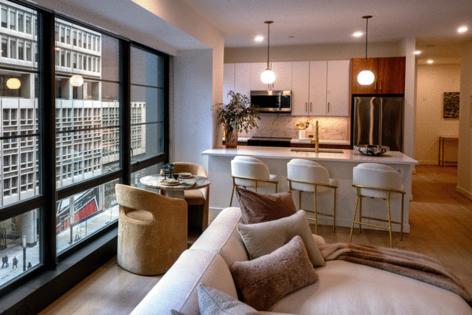The surprisingly smooth process of turning offices into apartments in Philadelphia's first big conversion project
Published in Home and Consumer News
The first major office-to-residential conversion of the post-pandemic era in Philadelphia is set to be completed this spring.
Alterra Property Group is on schedule to finish the conversion of 1701 Market St. from an office building to apartments by Memorial Day. Units will begin leasing in March.
For all the talk of transforming empty offices into residential buildings since COVID-19 struck in 2020, few such efforts have been undertaken or completed since the pandemic. The Alterra project — where there will be 299 units, 190 parking spaces, and a rooftop pool — is the exception.
Although several other conversions have been permitted in Philadelphia, 1701 Market will make it to market first because it was positioned perfectly for residential conversion.
“1701 is an example where many of the key factors for an office conversion came together,” said Connor Burke, vice president of multifamily acquisition for Alterra. “There will be other opportunities that will come up that have some of these attributes. It’s not every day that you come across one that has all of them.”
The Inquirer toured 1701 Market soon after Alterra began work on the building in January 2024 and again last month to learn more about why this conversion has gone so smoothly.
Single-tenant buildings are easier to convert
One of the biggest challenges to office conversions is that most buildings have multiple tenants with leases that end at different times.
That means that it can be difficult, if not impossible, to begin expensive renovation work if the building is still, say, a third full. (Whereas for an office building owner, such a dismal occupancy is more than enough reason to sell.)
“We have a joke in the office, what’s the only thing worse than an empty office building? A half-empty office building,” Leo Addimando, managing partner of Alterra, said at an event hosted by NAIOP, a commercial real estate trade group, early last year. “It’s an absolute nightmare.”
At 1701 Market, however, Morgan Lewis was the only occupant. When the building was vacated, Alterra could quickly and easily get to work. The development company had building permits in hand when the firm left, and they were able to begin construction immediately.
1701 Market is the right size
Unlike many of the towering skyscrapers that surround it, 1701 is a modestly sized office building for West Market Street at just over 305,000 square feet. No dramatic structural work was needed to ensure the incoming apartments have access to light and air.
The sheer scale of many post-World War II office buildings, or a prewar behemoth like the Wanamaker Building, presents challenges. The BNY Mellon Building, just west of 1701 Market, is almost 1.5 million square feet. Buildings of that size have large tracts of interior space far from windows.
People may be willing to work eight hours a day without immediate access to a window, but they are less amenable to living and sleeping in such a setup. That means office-to-residential conversions like the Wanamaker building will probably necessitate expensive demolition work to core out the middle of the structure to allow for more windows.
Postwar office towers built in the air-conditioning era are most likely to face this problem. 1701 Market was built in the 1950s, but its smaller scale is an exception.
“When you look at some of the other buildings in Philadelphia of this vintage, most of them are larger, deeper floor plates where a conversion might be more challenging,” Mark Cartella, Alterra’s senior vice president of development and construction, said during the tour last year. “The floor plates are really high on the priority list when you’re starting to look at buildings like this.”
In theory, any building could be converted to residential with enough money. But the various half million square foot, and larger, office structures surrounding 1701 Market are so big that the sheer number of units that could be created present another challenge. Getting an 800-unit building filled is much harder than in a 300-unit counterpart.
“An 18-story building like this is the sweet spot,” Connor Burke, vice president of multifamily acquisition for Alterra, said during the 2024 tour. “If it’s a million square foot building, you can convert it, but if you’re delivering 1,000 units, it’s going to take longer to lease up.”
It was in a good shape
Morgan Lewis’ corporate headquarters had been updated over the years, so Alterra was starting from a base that wasn’t in rough shape.
While the building dates to 1957, it was gut-renovated in the late 1990s to pave the way for the prestigious law firm. That meant the plans the developers were looking at as they strategized were only a quarter-century old, not over 70 years.
Further, the previous owner had invested in a large capital improvement program before the pandemic so building systems like the HVAC and water were already modernized and mostly reusable.
“The building was taken care of when it was an office building, so we were able to reuse a lot of the elevators and [other building] systems because of that maintenance that they’ve done,” Cartella said.
Floors two through five of 1701 Market had previously been converted from office space to parking, which gave the team a head start at understanding what lay behind the office walls when construction started.
“We could understand what we were buying [instead of just] demolishing and then trying to figure things out,” Cartella said. “We were able to have more of an expedited design development process and get in front of any unforeseen conditions.”
Philadelphia makes it easy
Following the pandemic, cities like New York and Boston struggled to create incentives and rewrite zoning laws to allow for the conversion of offices to residential uses.
In Philadelphia, however, much of Center City’s office core is already covered by the most flexible zoning laws in the code. That means conversions can occur without a trip to the Zoning Board of Adjustment, which can routinely add a half a year or more to project timelines.
The city’s 10-year property-tax abatement was created in 1997 to help an earlier generation of underused office buildings transform into Center City apartment buildings. But it also controversially applied to new construction, helping spur a building boom and creating inequity as wealthier, newer residents were exempted from property taxes as older, poorer residents struggled.
Philadelphia’s abatement for new construction was weakened in 2019 but remains in full force for conversions. It lasts longer and comes with fewer stipulations than similar policies in other cities.
Partly because of these zoning and tax incentives, Center City is already where most other American urban hubs only wished they would be in 2025. It is far livelier than most American downtowns post-pandemic, with residential and retail uses packed close to the office core. That proximity, in turn, makes it easier to sell expensive new housing.
“Some cities have offices in totally different parts of towns from where people live,” Burke said. “Center City is already densely populated, where you can be two blocks away from Rittenhouse Square and still be in the CBD (central business district).”
©2025 The Philadelphia Inquirer, LLC. Visit at inquirer.com. Distributed by Tribune Content Agency, LLC.








Comments